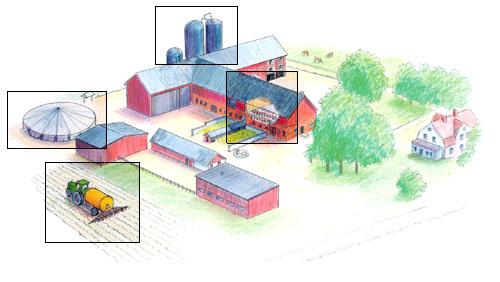LIFE Ammonia
 |
Sustainable milk production through reduction of on-farm ammonia losses |
 |
Ammonia is a gas which can cause damage to the environment through eutrophication and acidification of the ground and water. This causes changes in the composition between species in sensitive habitats such as meadows and heaths. Farming causes around nine tenths of ammonia emissions to the atmosphere.

Project objectives were to:
- Demonstrate an effective and innovative combination of techniques to reduce ammonia losses in milk production at farm lavel, by improving stalls, fittings, vantilation, manure handling and management, by adjusting the feeding to minimize ammonia emission from the manure, and by introducing slurry manure which was stored in a roof-covered container and later spread in growing crops, using a band spreading technique and incorporation, or direct ground injection,
- Increase knowledge in this area among farmers, advisers, authorities and agricultural students,
- Create a basis for future policies and legislation.
The project lasted from 1999 to 2004 and was carried out in cooperation with Lantmännen, Arla Foods, DeLaval, Svenska Foder, the Swedish Dairy Association, JTI – Swedish Institute of Agricultural and Environmental Engineering, and the Dept. of Agricultural Biosystems and Technology, SLU. The farm Brogården in Skara, with 40 Swedish Red cows, was used for demonstration purposes. The project was financed through funding from EU LIFE Environment, Swedish Farmers’ Foundation for Agricultural Research and the Municipality of Skara. Project Manager was Jan-Olof Sannö.
Here you can read more about the project:
- Conclusion with background, project organization, practical advice and publications
- Layman Report (pdf file, 900 kB)
- Final Technical Report to EU (pdf file, 1.9 MB)
- Project report: Sannö, J.-O. et al, 2003. LIFE Ammonia. Sustainable milk production through reduction of on-farm ammonia losses. Project report. SLU, Dept of Animal Environment and Health, Skara, report 5, 2003, 84 pp (pdf file in Swedish with English summary, 4,6 MB)